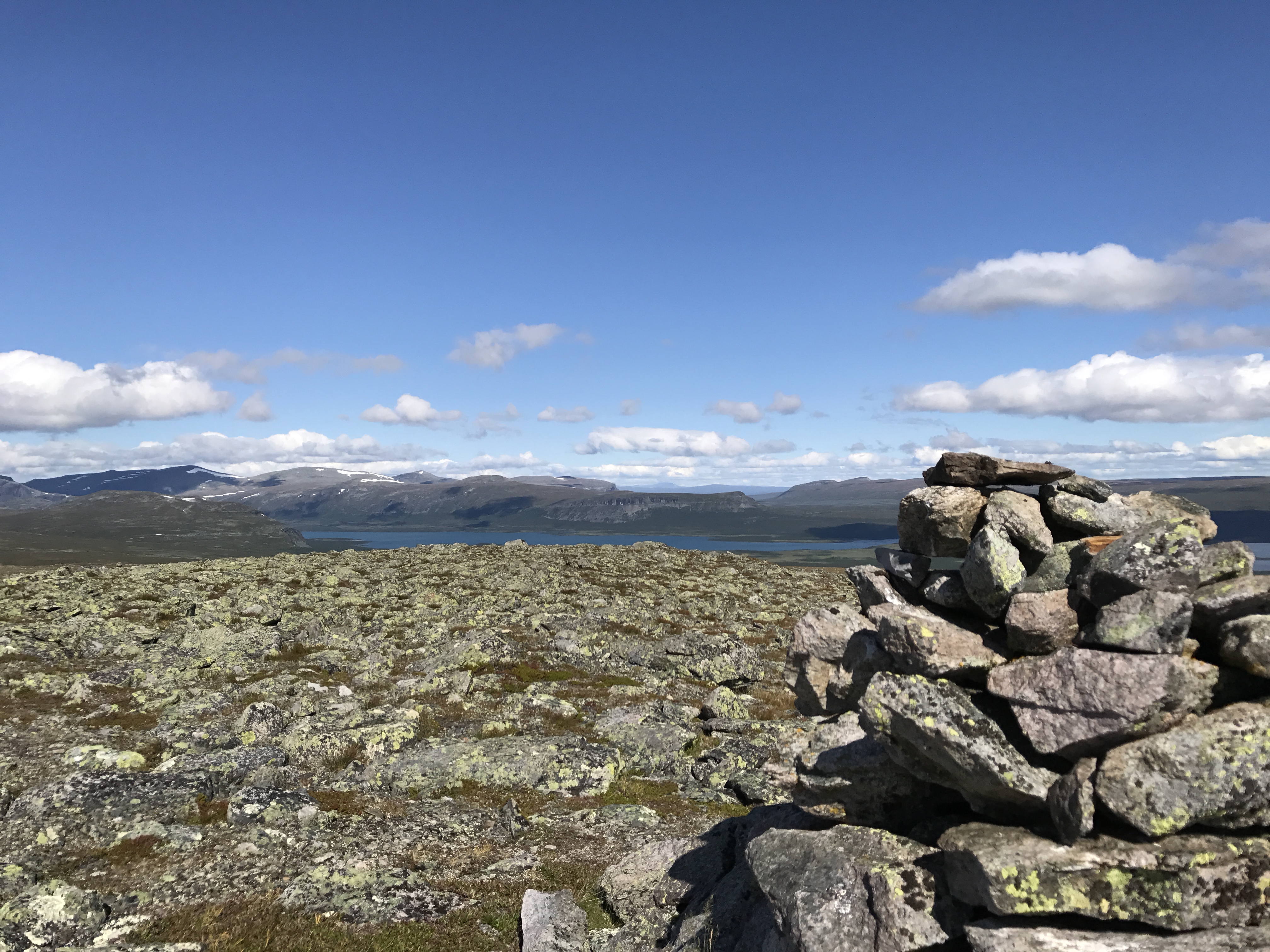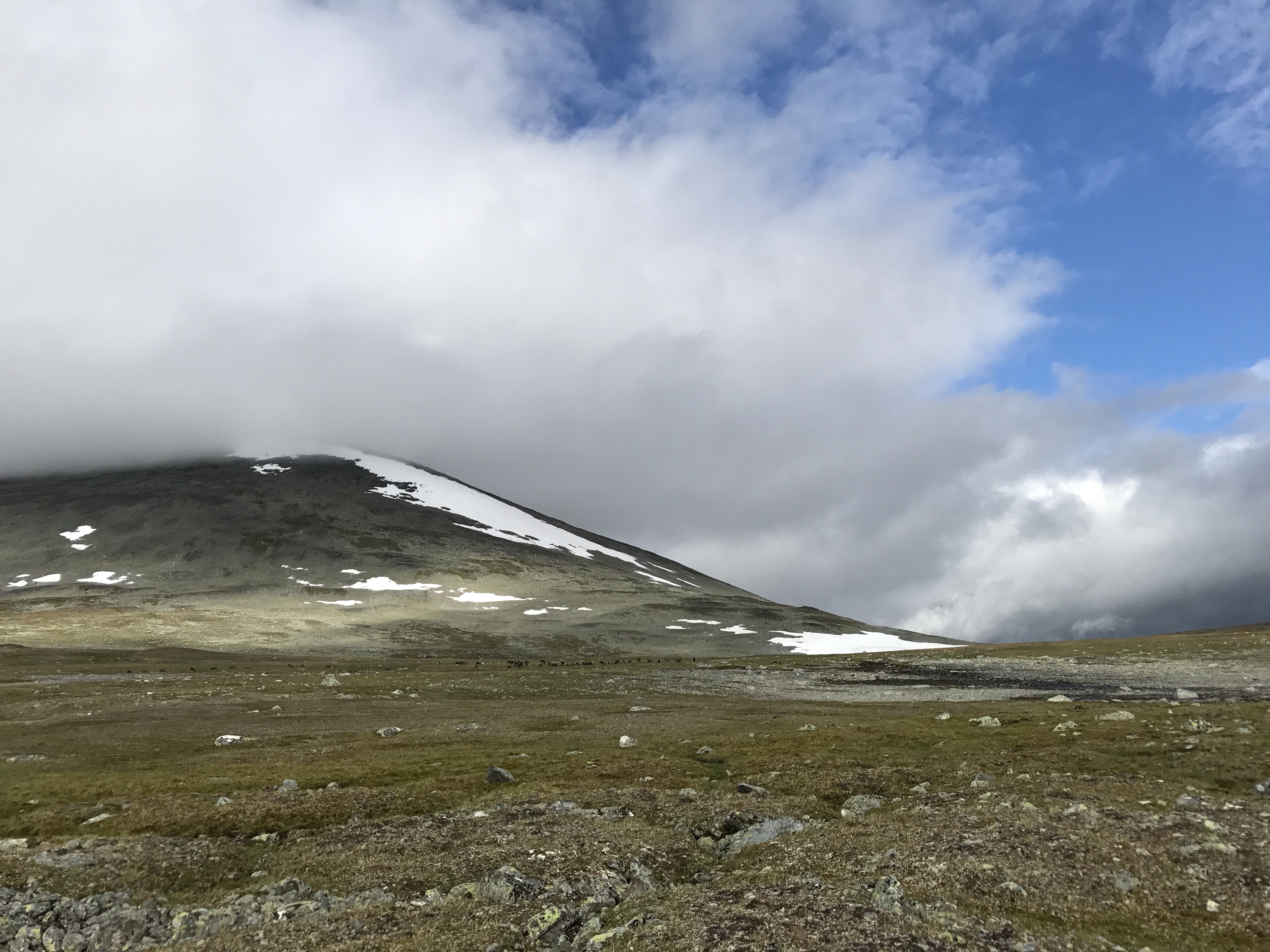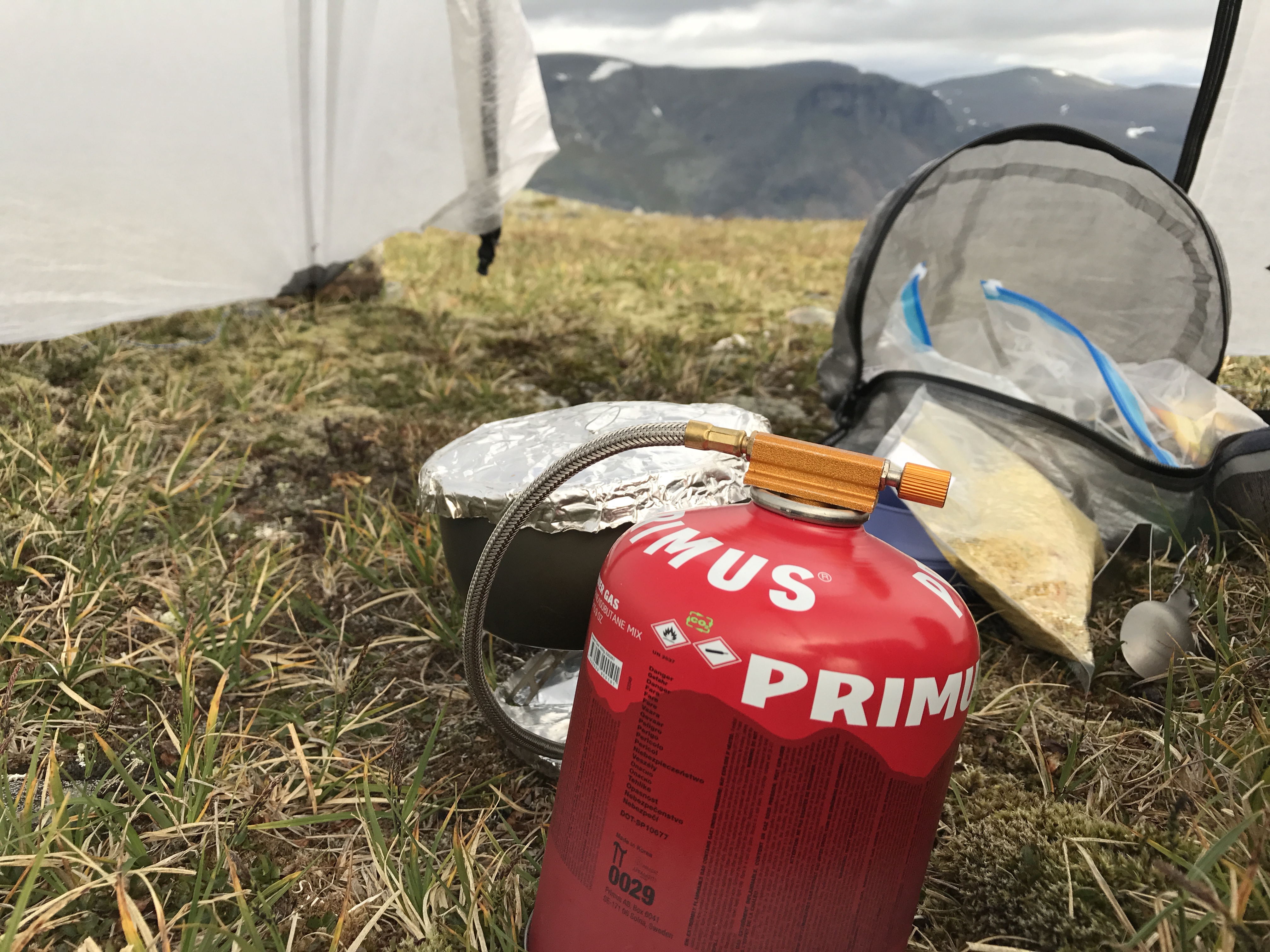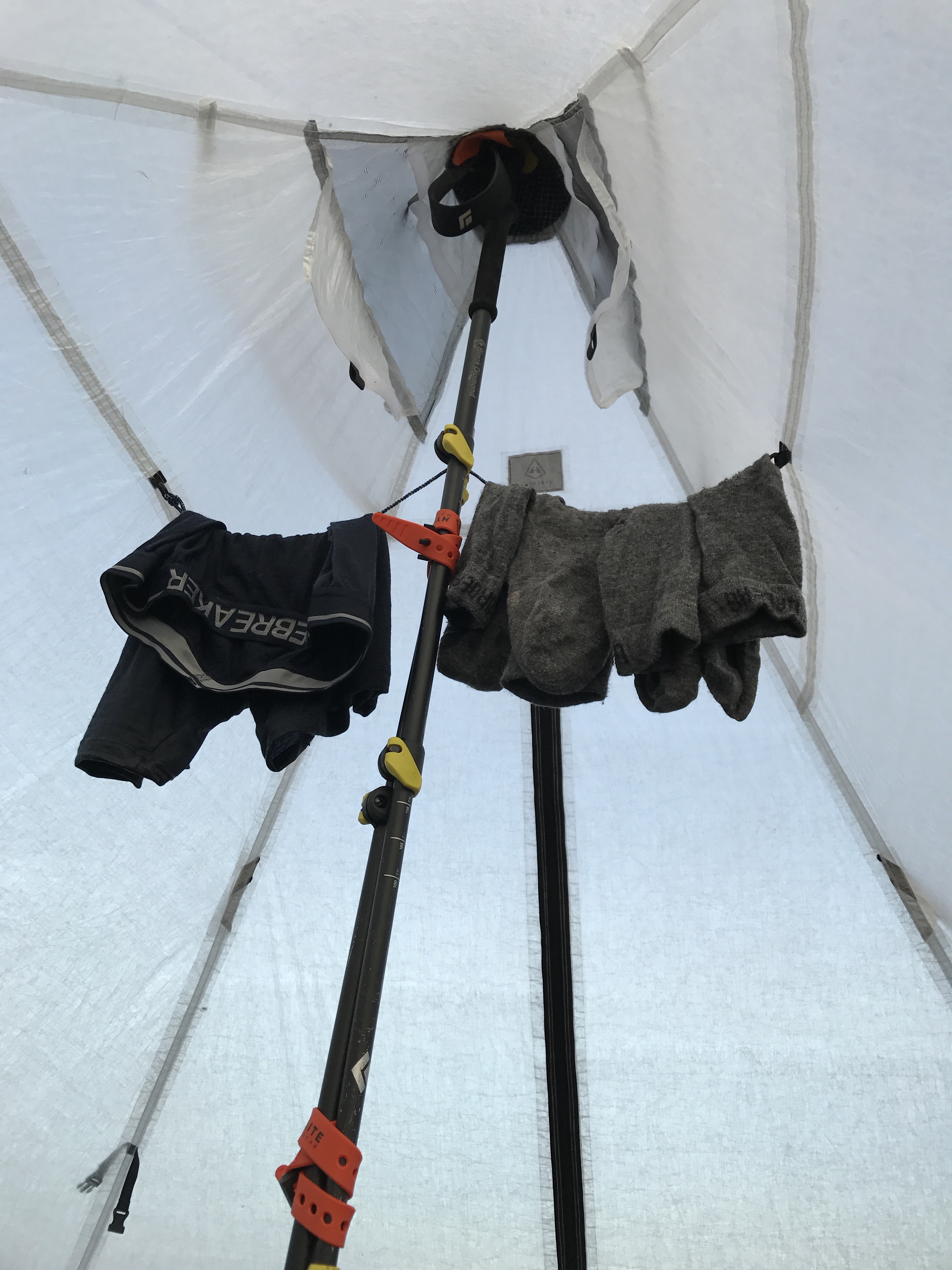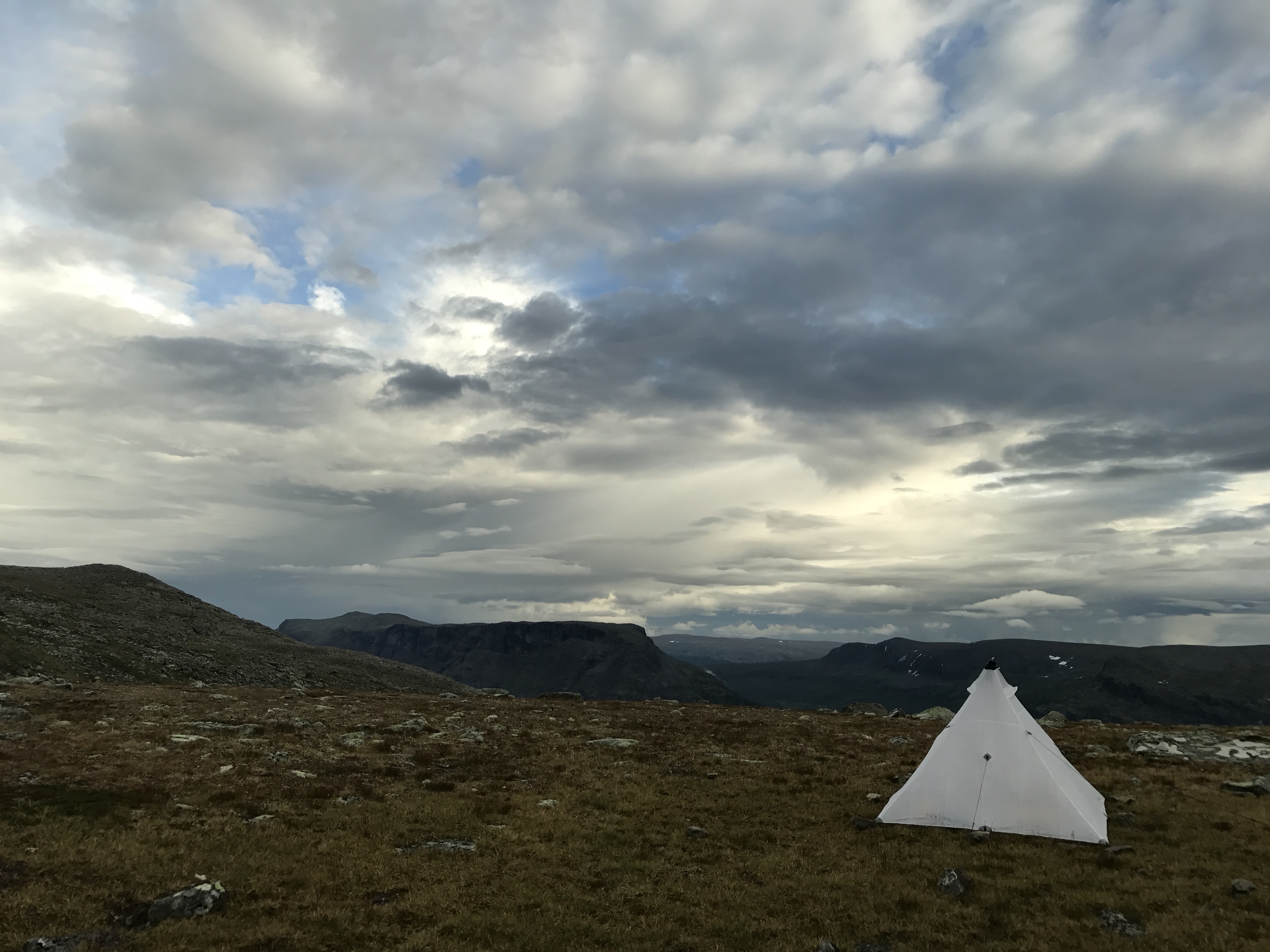Intro
Me and the family were in Greece this summer, seeing my wife’s relatives for the first time since before Covid. We had 2,5 weeks planned, but when it was time to go home neither my wife or C felt that they’d had enough of Greece. My wife had two weeks of additional vacation, and since we had bought “flex” tickets we rescheduled their flight to 9 days later. I had to go home with my son though, since he was going away to camp that week, and my oldest daughter wanted to get back home. With my son away at camp, and my oldest daughter an 18 year old who preferred to have the house to herself I suddenly had a week with nothing planned and no one to take care of. I already had a route planned in Hardangervidda from 2018, when I ended up canoeing in Femundsmarka instead, and decided to go there.
Since my wife and my in-laws were in Greece and my parents away on a trip I would be the closest relative to to take care of my son if he would get sick during camp. My daughter could take care of him until I could get back, but not for a whole week. Because of this I would need a way to keep in touch, and since there’s hardly any cellphone reception I decided to buy a Garmin inReach Messenger. It was really great, and though I like the thought of being totally disconnected in the mountains, it was actually pretty nice to be able to keep in touch with my family during the week.
Sunday
I dropped off my son at camp at 14.00, and immediately started driving towards Hardangervidda / Middalsbu. The trip was estimated to take 10h20 min.
I drove through Gothenburg and followed the highway north along the coast. I took a break before the Norwegian border to buy a hamburger and to refuel the car.
In Norway the route started with highways, but you were still only allowed to drive at 90km/h. Norway has extremely expensive speeding tickets, so I meticulously kept the speed limit. As I went further inland more and more distances would have a maximum speed of between 60-80km/h.
I was quite tired, and had thought about pausing and pitching the tent somewhere on route. But I wanted to be able to hike right away the next day, so I decided to drive on. I had time to regret my decision a couple of times, but the next day I was glad that I drove the whole way to Middalsbu.
Around 23.00, I saw a figure hitchhiking in the middle of nowhere. At first I wasn’t going to pick him up, but then I thought I would have liked someone to stop if I wanted a lift.
I didn’t think about how late it was, and in retrospect I probably wouldn’t pick someone up so late in the middle of nowhere again. It was a man who was going to Bergen, where someone had offered to give away a sleeping bag. He carried some stuff and a rolled up matress with him, and was very vague when I asked where he came from. I got the feeling he was homeless.
I offered to drop him off in one of the villages we passed, and explained several times where I was going, and that I was not going through any more cities. But he just kept saying that there wasn’t any road where I had planned to turn into Hardangervidda and I would pass citis, When I came to the small gravel road towards Middalsbu he looked a bit disappointed. I offered him some money for a bus, but he looked a bit offended and said he had money for a bus.
The gravel road was narrow, with steep sides and sheep both here and there so I had to drive slow. It was a welcomed sight when I came to the parking lot near Middalsbu. I had thought about sleeping in the car, but I still wanted to get a night in the tent. So sometime between 00:00 and 01:00 I hiked away from the parking lot to find a good place to set up the tent. I was going to go to the Middalsbu cabin, as I thought that there is flat dry ground there. It did, and by 01:40 I had gotten my camp up there.
I usually have trouble sleeping, but this night I passed out as soon as I laid my head on the pillow.
It was quite windy so I slept with the inner door open and the roof vent completely open, as there were no mosquitoes.
Monday

I woke up around 06:30 and got up to take a leak. The thought occurred to me to pack up, as there wasn’t any rain, but it would rain for the rest of the day. But I was too tired, and went back to sleep. I woke up from pouring rain, and occasionally from flies coming in, so I closed the inner door, but fell asleep again and slept until just before 10.00. I made breakfast in the vestibule and waited for the rain to blow over. Eventually it stopped completely. I wiped off the tent, and packed everything up.


It was time to start hiking towards Hellevassbu. It was only a 16km stretch, but the map calculated that it would take 7h. A good sign that it was a tough passage. And that was it. I met 4 people who all said it was tough, and difficult to follow the trail in some parts. It began with almost 10 km uphill, it was raining, then the fog came. There was a lot of snow left and with the fog you could not see across many of the snowy passages, and therefore could not see the trail markings. You just had to guess the direction. I got more and more tired, tripping on the slippery rocks and in the snow, and questioning my life choices.
In the end I reached the top, and it was flat for a while before it went steeply downhill again. Due to the melting snow and rain, all the waterways were filled with water, and it was difficult to wade across.

I thought several times about stopping and setting up camp, but I still wanted to go all the way to Hellevassbu to be able to dry my clothes in the cabin. It’s no fun putting soaking wet clothes in the tent and making everything damp.
Once I approached the cabin, I felt the wonderful smell of smoke. A sign that the heat was running in the cabin.

I took off my backpack by the cabin, walked away a bit and set up the tent and then went into the cabin, which was packed full with people. I hung up the rain gear, socks and shoes to dry in the overcrowded drying room. I had originally planned to eat by the tent, but there were a lot of mosquitoes there, so I decided to eat in the cabin while the clothes dried. There were a lot of people in the cabin, and I talked to some young Norwegian guys and to a German retired couple who were experienced hikers. The couple had set up the tent on the same peninsula where I had my tent.
Shortly after 21.00, my clothes were dry enough, and I left the cabin to lie down in the tent.

It had started raining again, and I hurried into the tent, unpacked everything and prepared the sleeping gear. I texted my wife goodnight on inReach and lay down to fall asleep to the sound of the rain pattering against the tent fly.
Tuesday
I didn’t sleep as deeply as the night before, and got up to pee during the night. I woke up around 08-08.30 but stayed a bit under my quilt before having enough energy to get up.
I made breakfast, coffee and tortilla bread with cheese and sausage. It was sunny, and at that moment it felt very nice to be in the mountains. Something that would change over the course of the day.


I had the camp near the cabin, and I saw how several people were already done and hiked away when I had my breakfast. There was some condensation on the tent, so I prepared the fishing rod and threw a few casts while waiting for it to dry up a bit. When I was younger I did a bit of fishing, but I was always bad at it. Last fall though, me and C started fishing together and it really sparked my interest. This was the first time I brought fishing gear to the mountains, and I had hoped to catch trout for the first time in my life.
After the tent had dried up a bit, I wiped off the last of the moisture on the tent and packed up the camp. My goal for the day was the mountainstation Litlos.
The German couple finished packing up at the same time as me, and we walked together towards the cabin. They were also going to go to Litlos, but stayed at the Hellevassbu a bit longer.
The Germans and I passed each other several times. When I paused, they passed me, and when they paused, I passed them. The weather was OK, and it felt great to be in the mountains, but hard to hike. My body was still sore from the day before.
I started walking towards Litlos, and it was a lot of uphill in the beginning. The sun had disappeared, but there wasn’t any rain. I had downloaded the weather report with my inReach in the morning, and it showed that the rain would come in at around 14.00.

Around 12:00 it started to rain. In the beginning it was not a downpour, but only a light rain. I had planned to eat at 13.00 and made the moronic choice to sit behind a rock in the rain and cook at 13.00 since that was my plan. Not just boiling water for a freeze dried meal, but frying bacon and cooking macaroni. It started raining more and more. Heavy drops and wind driven rain. I sat on a slope so the water ran along the cellfoam mat down to my butt. I would then discover that I had a 1,5 dm long tear in my crotch on my rain pants. I would also later discover that the water proof membrane was torn to shreds. The Germans passed me, and also another couple with 2 dogs who’d been camping just next to the cabin the night before.
I sat there behind the rock, cursing myself for deciding to cook in the foul weather, while my legs just got wetter and wetter. The rain jacket is good, but the rain pants were in worse condition than I thought. The lamination was torn, and now also a long tear in the crotch. They were rain pants by name only.
After dinner, I swore long tirades and packed up. I wandered with my aim set for Litlos, where I intended to dry up. I had first planned to continue the next day to Hadlaskard, but with the second day in veritable crap weather I was already getting tired of it. My upper body was dry, but my whole lower body was totally soaked and cold. I made my way across streams, paths turned into streams by the rain, and over blankets of snow.
I crossed some bridges. At a crossing with two bridges, a bunch of sheep crossed them. But at the second bridge, two sheep decided to be a little bit cooler than the rest, and go through the rapids instead, while the rest of the herd walked on the bridge above them. The rapids caught them, and I thought they would be done fore, but they did manage to get over safely to the other side.

When I finally saw Litlos, it was a wonderful feeling. I still swore and was angry with myself that I had gone here to Hardangervidda instead of canoeing in the warm and sunny southern Sweden, and that I could be lying in the hammock on an island in the sun and relaxing instead. Even though I saw Litlos from far away it felt like an eternity to get there, as it was on the other side of a lake, which I had to walk around.
About a km from Litlos I stopped to pitch the tent and put most of the gear in it. I brought some food, a book and water in my backpack and walked the last bit to Litlos.

I was shaking from being cold and wet. I went to the overcrowded drying room, where I hung up everything that was wet (which was everything). I started talking to a Norwegian guy who had been fishing during the day, and caught three big trout. He was completely ecstatic as it was his first time. We went into the main cabin, which was a manned cabin, bought beers and continued talking. He, like me, had fished sporadically in childhood, but a year ago he bought equipment and re-sparked his interest. It was the first time he got trout and he was in a great mood. He was going to sleep in a tent near the cabin that night, but had slept in the cabin the night before. He told me that a couple had celebrated their wedding anniversary in the next room, and he said they had physically “celebrated” through half the night, before they finally quieted down enough for him to be able to sleep. A young Norwegian couple sat down next to us and we continued talking. They would have dinner in the cabin. I had originally intended to eat a freeze-dried meal, but went and ordered dinner after talking to them. A three-course meal cost 560NOK, so I only took the main course for 260NOK. I was the only one doing it, so I felt ridiculous at first, as I sat with my water glass while everyone else ate their starters.
After dinner, I went to check on my clothes. There I met a UL-hiker from Denmark, and we started talking about equipment. My clothes were far from dry, but at least it was better than before. There was a break in the rain, which would soon return, so I took the opportunity to pack up and walk towards the tent. The wind was very strong. One person at the mountain station had talked about 20m/s, but I don’t know how accurate that was.
I came back to the tent, put up the sleeping mat and the quilt, put on a dry base layer and crawled under the quilt. The rain and wind increased again. My body ached and I was so happy to lie down and go to sleep. During the night, the wind and rain increased even more, but I felt confident that the tent could handle it without any problems, and went back to sleep.
Wednesday

I woke up to a sunny day, and it was hot in the tent. It was a wonderful feeling after yesterday’s cold and wet experience. I really just wanted to lie in the tent and relax all morning, but I knew that it would likely only be nice weather in the morning, as the weather report showed rain later during the day. When I opened the tent, I saw a couple walking by. It was only 08.00, but they were already on their way.
I made breakfast and packed up my things. By 08.50, I was on my way. It felt great to walk in the sun. I stared to love hiking again, after having quite the opposite feeling about it the day before. I wasn’t going to go far today though. My plan was to hike back towards Middalsbu via Vivassdalen, and take two days for that streach, setting up camp early and spending the days fishing in the lakes along the way.
The rain, which was supposed to come at 14.00, came already at 10.30. But by then I was already at the southern end of the valley where I had planned to set up the tent. I stopped there and set up camp. When I crawled into the tent, the rain got a lot worse. It was nice to be inside the tent this time, and not having to hike through it with my torn rainpants. I waited out the rain, which lasted for an hour, until the sun came back out. I took the opportunity to prepare the fishing gear.


I went down to the lake and threw a few casts. It was shallow. I started with a Toby trout lure, then a pink Vibrax spinner, my designed jig from Kanalgratis, and then back to a Toby. But I just caught seaweed. I wasn’t sure if there even were fish in the lake, or if it was shallow enough to freeze through in the winter. I threw some more, but then headed back to the tent to make lunch. I made bacon with macaroni and parmesan. When the food started to get ready, it started to get windy and rainy again. I closed down the tent and ate my lunch snug an secured inside. After that, I laid and read for a while. The weather switched between rain and sun, but the rain came so often that it was not worth going fishing. I also took the opportunity to tape the tear on my rain pants with duct tape. They would still be bad, but at least provide protection for a little longer than otherwise.
I stayed in the tent for a while to read, but finally got out, since I wanted to get up on a peak that was behind the tent. I begun to get up, but it started to drizzle and really dark clouds were coming in. I had the rain gear in my bag, but still didn’t want to risk getting soaked when everything finally started to dry up. I went back and hunkered down in the tent, but no downpour came, and when the sky looked pretty clear again, I begun my ascent. The peak I was aiming for was too hard to reach though, so I choose another peak instead. The view was amazing. I also got a good view of the lake, and saw a spot where I thought it would be nice fishing. I admired the view for a while, and then went back down.

At the tent, I made a snack, and then took the fishing gear out to try my luck at the spot I saw from the top. I put on a dark copper Toby and began casting. On my second cast, I got a fish. A nice big trout, and the first one I’ve ever caught. I was ecstatic. I had said to myself that if I only get one trout on the whole trip, the fishing license I bought would be worth it. I saved the trout for dinner, and cast again. Immediately I caught a bite, but this time it was a small trout, so I released it again. One more throw, and another fish again. An even bigger trout than the first. I had to fight hard to get it in.
I had an adrenaline rush from the fishing, and I really like eating fish. It felt absolutely amazing to have caught my own dinner, which would taste a lot better than freeze dried meals. I didn’t cast any more after that, since I didn’t want to pull up more fish than I was going to eat that night.

I cleaned the fish at the edge of the lake, and just when I was done, dark clouds and wind rolled in. I ran in the drizzle towards the tent, and the rain started pouring down just in time for me to get inside.
Around 18.00, I decided to fry up one of the fishes. I planned to keep the second one for breakfast the next day. I fried it in butter and rapseed oil, and seasoned it with lemon pepper. It tasted amazing and I wanted more, so I fried up the second fish too.
I washed the dishes and laid down to do a bit of reading. It started to get cold and rainy again. At 20.00, I started to watch Star Trek on my phone, which was the only interesting thing downloaded on my Netflix app.

I texted my wife a bit on the inReach, and then laid down to go to sleep.
Thursday
At first I had trouble falling asleep, but in the morning I also had a hard time waking up. I woke up around 08:30, but had a very hard time getting started. It was cold, cloudy and drizzly outside. I put on my down jacket and made breakfast while I stayed under my quilt. When I finished breakfast and packed my sleeping gear, the rain started pouring. Since I wasn’t in a hurry I stayed in the tent a little more, to let the rain blow over, and to let the tent dry up a little before packing it down.

I started hiking. The route was flat, but very rocky with a steep side down to the lake. I slipped once and started sliding down towards the lake. There was snow and ice left in the lake. The weather, which started with a drizzle, turned to wind-driven freezing heavy rain again. I had been aiming for a lake to set up my next camp, and I didn’t want to pause in the bad weather. I thought I would get there faster than I did though. The weather was absolutely abysmal, and the taped up tear in the rain pants went up after only a few minutes. The rain pants soaked through in 30 minutes and then I was soaked and cold on my entire lower body. I felt dry on my upper body for a long time, but after several hours of heavy wind-driven rain, it turned out that the rain jacket had also wetted out and soaked through.



I am usually able to keep my temper, but several times I completely lost it in the horrendous weather. I hacked the hiking poles furiously in the ground and shouted curses at the mountains for dealing me such crappy weather.
My knees, especially the left one, began to ache from exertion and being cold and wet all the time. It just got worse and worse, and eventually I had to limp and drag myself on the hiking poles. I arrived at the lake where I was going to camp, and set up the tent.
I lay in the tent for a while. The rain stopped, the sun came and went, and I managed to dry up everything except shoes and socks. In the evening I limped to the lake to do some fishing. I thought the nearest place would be bad, and I only caught vegetation. I accidentally ripped off the line at one throw and lost my copper Toby. I went to a another place that looked good, and quickly caught a small trout. I released it and threw again. But the lure got stuck in a bush, the line was torn off, and I watched my silver Toby fly in a wide line out into the lake before disappearing under the surface.


I limped back towards the tent. The knee felt worse than ever, and without the hiking poles with me, it was a struggle to get back.
I laid in the tent for the rest of the evening, and finally fell asleep.
Friday
I had a little trouble falling asleep, but in the morning I slept like a log, and had to force myself to get up. I wanted to get started early, and had a quick breakfast before packing up camp. The weather was beautiful.


The knee was a little better, but still hurt. It was possible to walk if I walked with my leg straight and kind of threw it out with each step without bending the knee.
Near my campsite there was a strange cottage, which looked sort of like a Hobbit house. A young couple sat outside and invited me for coffee and chocolate. I declined a couple of times, but as they continued to insist, I accepted and had some coffee with them. It was a young Israeli couple that Air-BNB rented the cabin. They had arrived the night before. We sat and talked about all sorts of things for about half an hour before I moved on.
I managed to hike quite well, but when I was almost at the parking lot, my knee gave up completely. I had to drag myself down the last bit of the trail before I got to a flat road that was easier to walk on. I got to the car, looked at the beautiful but treacherous mountains, and packed up. It was a struggle to get my leg into the car, and it hurt to use the clutch, but it eased up after a while.


I drove for about an hour before making noodles for lunch at a rest area in the mountains. I also stopped at Heddal Stave church, which is a beautiful building.

My oldest daughter wrote that she preferred me to come home on Saturday instead, as she would have friends coming over. Since I wouldn’t arrive until around 01.00 anyway, I thought I’d pause on the way and spend one more night in a tent.
I didn’t find any good place when I searched my phone for it, but I wrote to an Instagram friend who’s camped a lot on the west coast for tips. She sent some links, and then I saw that Kosterhavet national park was close. I found a cape on the mainland that was part of the national park where you could camp. I went there, but the parking lot was 2.5km from the national park itself, and was instead in a nature reserve with a camping ban. I was a bit worried about how my knee would cope with the hike, but it went well and at the far end of the cape, just in time for a nice sunset, I found a perfect camping spot. I pitched the tent and felt happy to have such an end to the trip. From 6⁰ C and icy wind-driven rain to 20⁰ C, sunset over the sea and not a cloud in the sky. It felt like paradise.


I laid in the tent for a long time with the view of the setting sun and really enjoyed myself, on this last night of the trip.
It had been a strenuous trip, both physically and mentally. The weather made it more challenging than I thought, and the torn rainpants and busted knee made it even worse. But the last night at the beach, and the trouts I got made it all worth it.
Significant gear
(Disclaimer: Below list contains affiliate links, which means I get a small commission for purchases made through the links. The gear is bought with my own money though and I have not been asked to review the gear. Good lightweight gear can be bought from backpackinglight.se in Sweden, or backpackinglight.dk for international shoppers. It’s run by Kenneth Shaw, who blog at https://ultralightandcomfortable.com/ )
I’m really happy with my gear right now. I thought I’d find the Soulo too heavy, compared to a lot of tents I’ve tried earlier, but I really loved it. I feel confident that it’ll handle everything, which makes me sleep well in poor weather, and I like that the inner can be opened up fully. The quilt is amazing, and I’ll never go back to a 3-season sleeping bag.






































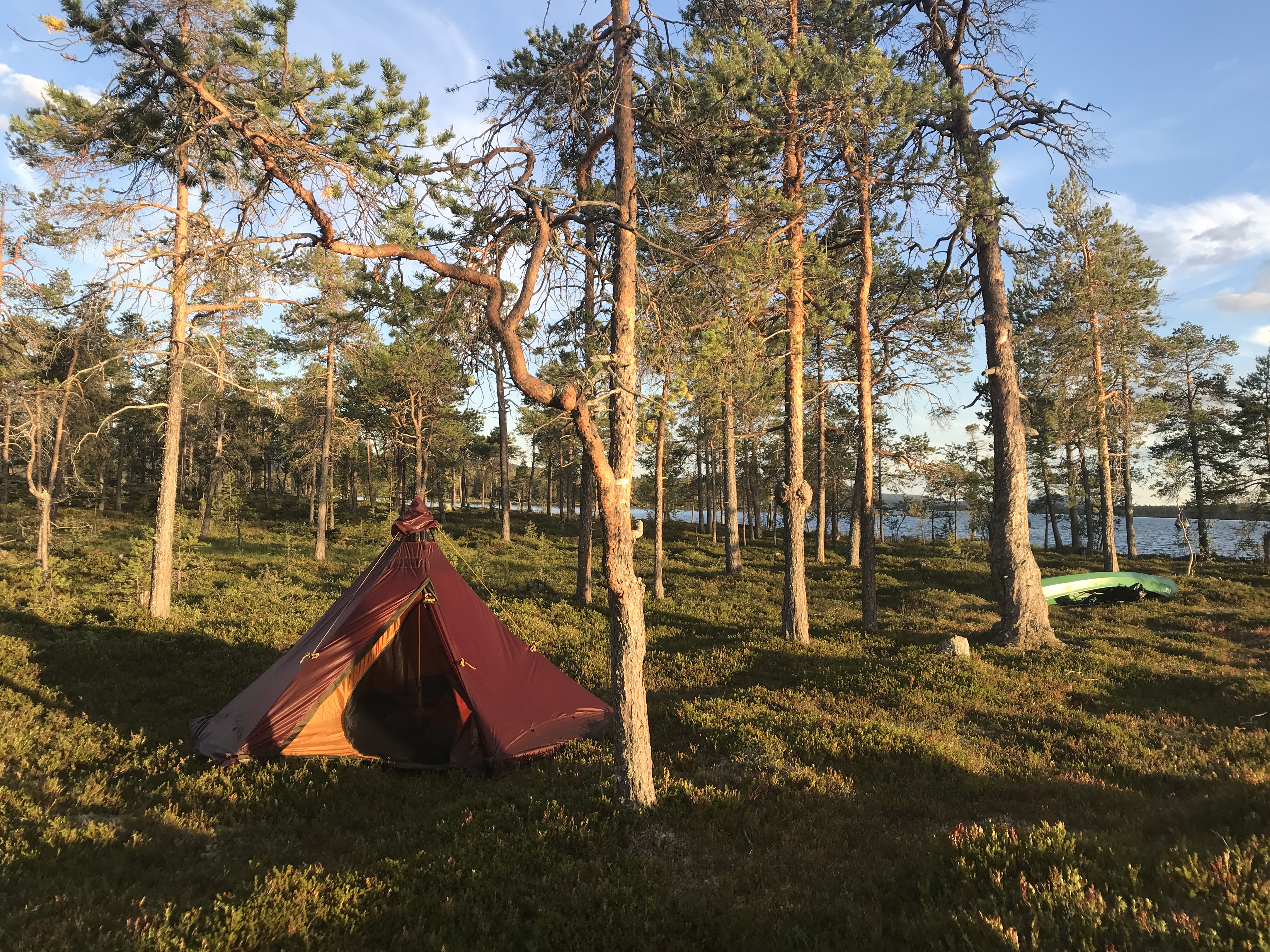











 It had been getting colder during the day, and I put on my fleece, down jacket, wind jacket and my down booties. Boiling water was a pain, and my fingers got numb from trying to heat up the gas canister. Despite me having under my jacket to keep it warm. I was however able to make dinner eventually. I also boiled water to keep in a bottle wrapped in socks as a radiator in my sleeping bag.
It had been getting colder during the day, and I put on my fleece, down jacket, wind jacket and my down booties. Boiling water was a pain, and my fingers got numb from trying to heat up the gas canister. Despite me having under my jacket to keep it warm. I was however able to make dinner eventually. I also boiled water to keep in a bottle wrapped in socks as a radiator in my sleeping bag.






